the transition of idea to physical reality |
| This is one of the most important of all the Taylor Models and one of the least understood and used. It makes a distinction which is almost always overlooked in the understanding of how ideas transform through multiple iterations of work and how they are expressed in different forms as they travel from metaphysical to physical reality. |
| The distinction is that an idea does not smoothly evolve through the creative process it transforms through re-creation at each of the major transition points along the path. This recreation is forced by many factors. Primary ones are iteration: the feedback to an individual or group of their own work (as an output) - from self or from others - and how this effects their concept, intension and subsequent work; recursion: the passage of time and (as an input) the ongoing influences from new, self induced thoughts, from colleagues, society and stimulus from the world at large; and, in most projects, the form a work takes as a natural consequence of development, modeling, communication and testing. |
| The Solution Box Model is a map of this journey and the Zone of Emergence Model shows how iteration, recursion, and feedback combine to induce a system break and change - a synergy - resulting in a outcome both purposeful and yet not predictable nor predetermined in the specific. |
|
|
|
The Solution Box is composed of three models: The Creative Process, Vantage Points and Design Formation.
These form a matrix of 343 discreet transitions each requiring their own unique language, criteria of veracity, work methods and tools.
click on the graphic for more |
|
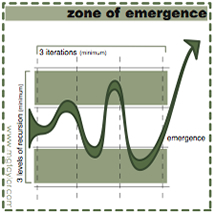 |
The Zone of emergence Model frames the conditions and essential dynamics of iteration, recursion and feedback necessary for systematic yet open-ended emergence in agent interaction, collaboration and design.
click on the graphic for more
and go to: valueweb mechanics |
|
| The 4 Step Model is relevant on both the large scale of an effort and at the may discrete steps which may be involved with the effort. Generally, an idea goes from mind-space to physical representation to group effort, then to evaluation and feedback. Then, of course, back to mind-space. This same process happens at many of the intersections of the Solution Box. Generally, it is Design Formation - the form an idea takes in any iteration of work - which drives each iteration of the 4 Step process at the sub-system level. |
|
...Walking Through the Model |
This Model is a map of the physical transformations an idea takes as it is manifested in different media - thus, forms - as it moves from concept to a broadly shared social artifact. |
| The Model addresses a commonly over looked fact: that the form an idea can take is both augmented and attenuated by the media by which - and in which - it is rendered. This gives rise to the requisite variety issue and requires understanding of the symbolic nature of different media systems and realizing that they themselves constitute a language when used within a refined field of knowledge and craft. For example, a set of architectural drawings has to be understood in this way if they are to be employed properly. These drawings are a construct employing words, symbols, literal representation and graphic conventions that convey information and nuance. The convention is general to the field and different regions of the world make their own adaptations as do most individual architects and draftsmen. Over time, the connection between the drawings and the finished building become codified and thus a visual-verbal language is established that can “hold” a great deal of information in a brief package. It is important to understand that the majority of this information is actually in the mind of the drawing makers and users - not on the paper. What is on the paper triggers memory [link: the 22 aspects of memory]. |
| The insight of the Design Formation Model is that when the rendering - the form it takes - of an idea moves from one of the four meta-forms (Vision, Template, Act-Work, Evaluate-Feedback) it cannot be copied - it must be recreated in the language and within the boundaries of a specific convention and media. If there is an attempt to copy the idea, and merely stuff it into the new form, it will lose integrity. Few would argue that an idea can be copied into the new media expression or that it should be - however, the default practice is to “try” and do so. If the idea, instead, is recreated this forces a cognitive shift and a whole new cycle of the creative process and therefore this act can significantly advance the idea. A copy loses resolution. A recreation adds new value. The implications of this insight, in the practical world of organized invention, are enormous. |
|
|
Vision in this model references the mind of a living being holding a concept, design or intent. In this paper, I will focus on the recursion level [link: system recursion levels] of a single human rL3. It is legitimate and useful to thinks of teams, groups, societies, humanity - even Gaia - having a vision although the kind that it is and the form of it is, naturally, different depending on the recursion level and thus the composition of the “mind.” |
| Mind, in a human is timeless, multidimensional, extraordinary high variety and multi-media (emotions, senses, intellectual constructs, images and so on). it is also fluid as the mind can morph an idea endlessly with ease. This is why frank Lloyd Wright practiced and taught his apprentices the disciple of “imagine the building fully in the mind before committing it to paper” [link: fllw autobiography- rbtf book]. This is not a trivial point. If you “imagine” - vision by sketching, you are actually jumping to the second step, Template. Your are thereby constrained by the media. If you get the idea clearly in mind and then “sketch” in different media you are now exploring different ways the idea can be rendered, augmented and expressed by different media. These are entirely different means. The feedback to mind, of different media is strong. Prematurely employed, media unduly influences mind-space work. Used properly, at the right time, media can help “draw out” at least one expression of the idea. |
| As such, the amount of information that can be held in mind is enormous. Layers of connections radiate outward from a single idea be it held in words, in visual form or both. Feelings, kinesthetic and other senses - and ways of remembering - are also involved and sometimes dominate depending on the subject or mental propensity of any particular creative mind. This complexity cannot be captured in a drawing or written document. If one tries to copy this cornucopia in the far more limited form of paper or even multimedia, the result will be a watered down parody of the rich fantasy of the original idea. |
| This in-mind work is usually associated with the programmatic and schematic cycles as mapped by the Design Formation Model. Not always; Tesla, for example, was reported as having the ability not only to draw straight from mind detailed working drawings (Design Development - Contract Documents) and also to run a test of a new piece of equipment in his mind and accurately predict its moment of failure (Use - Feedback). How rare this talent actually is or how rare it seems because of the way the design process it taught and practiced, I do not know. While there is no harm - and often good - in “sketching” and keeping notebooks on a project, it is worth while to practice keeping an idea in mind-space, during the incubation period, until there is considerable clarity, before undertaking the task of its recreation. In a DesignShop® event, this is the SCAN. |
| Mind-space is fluid. Multiple versions and variations of an idea can be held at once. Ultimately, the idea-concept has to be put into an external, objective form that both concretizes the design and communicates it - in a formal language, which itself has embedded content - to other minds. |
|
| The Template is the first transition from metaphysical into a physical expression. I call it a template because, whatever media used and the form taken, this form is a specific rendering of the idea constrained by technology, conventions, rules, economy and intended use. It is not the full idea. It cannot be - it is one expression of it in a time and place. |
| The Template is governed by the Design Formation Model in terms that are appropriate for the specific kind of work and the intention of the use of the design (or work) as rendered. A book concept going to a possible publisher might be rendered in Program or Schematic level of formation in the form of an outline of chapters with some sample chapters written out. The idea and style of a work is thus expresses yet it is understood that there is much to be developed before a book will be possible. Publishers have a form (with some variation from house to house) they like to see the work rendered in. The form is a convention and language that facilitates fast comprehension of the proposed work. Publishers (and this again varies some amount) do not like to see a work too unformed nor too complete at the selection stage. |
| Compared to mind, any template (writing, drawing, picture, model, etc.) is a low variety experience limited by its specific physical characteristics and the economy of time, place and a “manufacturing” process. This along means the idea cannot be copied into this far more limited medium but must be recreated as a specific expression of a more general idea. |
| What may seem to some as redundancy on my web site is not in context of this model. Every time something is written, drawn, looked at, listened to - is a different rendering of the work. Context and place also contribute to meaning. The time of day you are reading this alters the content - remember, the content is not on your computer screen, the content is of your body-mind. Where you are, what is going on in your life, the time of year, state of the economy - all matter. The me who wrote this piece in October of 2006, is not the me who conceived the Model in 1982, nor the me who is adding this paragraph in December of 2008. This is why I always reread a piece when I send it to someone (which is how I got into this editing session). Otherwise, I do not know what the me who is now actually sent. |
| My architectural students ask me how do they know when the drawings are done? I tell them “when you can’t get any smarter by drawing.” How do you know when it is time to go from one of the 4 Steps to the next? When the information curve drops off. When the idea stops growing. When you cease learning. When it starts to bore you. And, by the way, when you run out of time and money. These are signs that it is time to ship the product, which means to reinvent it and get feedback by use. This web page on the 4 step Model was done by me in concert with a workshop with the World Economic Forum Team in preparation for the 2007 Annual Meeting. This was the context for this version of the concept. I rarely develop or document theory or models unrelated to a project or event of some kind. Nor, do I design without recourse to ideas, models and a multi generational context. |
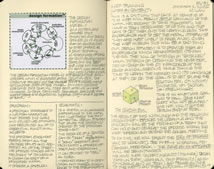 |
| My hand drawn Notebook pages FV 31 through FV 40 dated 10/02/06 to 11/01/06 span the workshops preparing for 07 Davos. This web piece is a later iteration near the end of this cycle of work. How the hand notes relate to ths work can be easily seen. Click on graphic for full screen view. |
|
| The Taylor Method discipline is to do rapid iterations of work - each shipping a product useable by participating ValueWeb members - getting feedback - thus, enhancing the knowledge-base of the web, and doing this through all the Design Formation expressions and ultimately manifestations. We call this the Ten Step Knowledge Management Process. |
| The Ten Step Process is a knowledge building ENGINE. Knowledge cannot be managed, in the conventional sense of the term, any more than people can. To happen it must be built in to all work. Click on the graphic for more. |
|
|
| The SolutionBox offers a road map and criteria for each way point along the journey of idea to reality. The 4 Step Recreation Model describes the transitions which take place at each cycle of work. The 10 Step Process builds the knowledge base for the entire community-of-work engaged in the effort. Together, the three articulate a sustainable Engine of Creation. Many organizations have developed good models of creativity and learning. Many have worked to foster a culture in which innovation can thrive. What is often lacking is a process architecture which sustains collaborative effort across organizational boundaries and over time. The Taylor Modeling Language - as terms-of-art - enables us to perceive, think about, and precisely communicate - thus facilitate - the status of ideas, designs and people’s progress during the process of bringing concepts into practical form and use. Like with any language, perception, conception, thinking, feeling and action become tightly bundled and recursive. |
|
|
hand drawing of 4 Step Model with notes - February 1984
click on drawing for full page view
|
|
The Act - the doing of Work - is always a social process even when apparently being done by a single person. This is the transition, from an idea expressed in some form - the Template - which is intended to show or demonstrate an idea in order to encourage or support the ACT process. The Template may be done by an individual, a team, a group or organization. The Act is the manifestation of the idea in the environment of its intended use. This environment - often called the real world - although this distinction is problematic - is made up private areas and commons- private wealth and commonwealth, local and regional, as well as global connections and ramifications. The resources required to build the most simple work often come from all over the world and the resulting artifact can often impact the whole world. This world is a complex, always changing MEDIA. The idea, is now being expressed, again, in a high variety environment. No matter how detailed and perfect the Template, it cannot explain and anticipate all of the conditions in the material world of the built idea. It is feeble and useless to simply try to copy the drawings when building the work of architecture. The idea must be recreated once again. In this new world with conditions which have to be met, physical, financial and political constraints, social conventions, and billions of people, the idea is rendered once again in a new way. And, this new world is altered by the new form which the idea takes - perhaps imperceptibly, perhaps mightily, nevertheless the world is forever changed. |
| In the world with pixels and the Internet, the hard distinction between Template and Act becomes blurred. This is one reason why I “publish” my Notebook - hand drawn and web site - in real time. Even in this nascent form, my ideas and drawings are having impact on the world of molecules - however, there still is a distinction between a work-in-progress and a published book (even if electronic), and, between the most realistic of “walk through 3d drawings (even if a virtual house which avatars can visit) and a built house. There is a formality and completeness which define ACT. This recreation of an idea, concept, design, is where it matters. It is the stage where major dollars are invested and risks are taken. In this space, the idea is tested for fitness in a complex, dynamic environment - it becomes fact based. It must be build-able. It requires the participation and collaboration of many people - often tens, hundreds or thousands of thousands - to be made and used. It becomes what we call objective, “outside” of ourselves, something that the creators can experience as done. It is here that the idea has utility. And, it is here that it becomes art to be seen, heard, felt, experienced. |
|
| This step is Feedback. Feedback requires evaluation and is necessary to evaluation. In this model, feedback is employed as a term-of-art not the loose open-ended comment, “let me give you feedback,” that has become the social convention. “Feedback” - as defined and used in the Taylor Method - is “the message to the controller of a system, from a sensor of the system, of the difference between performance and expectation (measured by a defined standard). |
| Feedback loops - negative and positive - have to be carefully designed and built into a system if stability is to be accomplished. When making an electronic circuit, engineers understand this. When managing an a corporation, few business people think of this as a structural design issue which will have a huge impact on the behavior of the entire system. |
| In the case of this Model, the feedback is both forward and backward. There is some merit in backward feedback mostly in terms of learning how to improve the process. To actually correct or change the prior work is of minimal value and perhaps great expense. The main focus of the feedback it to the Vision, itself, and how this vision, informed and improved by the experience of bringing the idea into form and social reality, can be better understood and brought forth in the next cycle of expression and work in a more powerful and useful way. The temptation to direct the feedback, back, to the work done - which can never be made undone - is almost overwhelming and usually crippling to an organization. If directed FORWARD to the VISION we discover the flaws in the Vision, our understanding and development of it and how we worked during the task of bringing it into reality - this can be improved in future iterations of its rendering. This is useful. It is economical. It is moving forward keeping iteration cycles intact. Feedback, BACK, is at best corrective to the “old” vision and knowledge and sometime necessary and of some value. Great care should be taken in its exercise. |
| The cycles time through the 4 Step Process should be high frequency and low magnitude. This promotes continous learning and adjustment. Many small errors, quickly found and easily fixed are better than a low frequency high magnitude process that tends to produce - at the end of a long cycle - large errors which are traumatic and expensive to fix - if they can be fixed at all. A trim-tap correction takes far less energy than getting in front of a ship and trying to push it in the right direction. It is a simple matter of mechanics and human systems are not different in this regard than a mechanical one. It is is just that we tend to design better mechanical systems than the way we “design” the structure-process of our social conventions and our economy. I discuss feedback - its uses and abuses - in my 2003 web piece Positive Feedback [link: when extreme adds to extreme]. By always directing feedback forward to rethinking the Vision, and by moving through the 4 Step process quickly, through the entire Solution Box, The Vision and its manifestations get better and better faster and faster. The Vision has impact from the beginning and cybernetic: it fits into the environment of which it is both changing and becoming part of. This kind of change is, more often, smooth to accomplish and benign in its outcome. Too much of our organizational and social-economic change today is “blunt force trauma” rather than the skillful application of design a human focused project management. |
|
|
Recreation is the heart of this model-process. It is a design discipline as important as an engineer knowing the equations necessary for the task of designing a beam. The habit, when moving from one stage to another in the creation process, is to try to render the idea as it stands in terms of the requirements of the next stage of work. In other words fundamentally copy it. The copy - like any copy loses fidelity and the requirements of the new phase then tend to get added on to the old conclusions thus be compromised themselves as well as diminishing the original concept. The paradox is that in order to make the original vision live it has to be let go. Recreated it lives, copied it fads and dies. Recreated it becomes requisite with the “world” it is in, copied, it is unlikely to do so. |
|
...the Model as a System and Process |
| In this System and Method, the models have to be understood and employed on multiple levels of recursion or too much meaning is lost. A model is not the reality. It cannot contain all the complexity of the thing it is representing. If it had that fidelity, it would be the thing. A model is an abstraction and brings focus to certain features to the exclusion of others. It is, thus, a “distortion” of the real thing - a useful tool, however, if used properly and treated with caution. We have several models which focus on different aspects of the creative process. It is not possible to show all of these aspects in one model which is why we use several. They are, in relation to one another, both iterative and recursive. Each Model can be treated as a system and each can be a sub-system of another and also to many other Models of the Method. |
| It is with this interplay that the Models and their component become a language [link: modeling language]. And, it must be remembered, like any language, the “words” are a symbol-sound which represents and partially denotes and connotes something real. Language is a powerful means to understanding and a tool of intellect. It is most useful in applying the “executive routine” of a process. Words are no-things which have a powerful relationship to things. Language is not the only way to understand something and this is particularly true with the creative process which requires all attributes, modalities and skills of an individual and group. It is rarely useful to think about the creative process while doing it. It is useful to think about the process when setting up the environment, the process design and the technology augmentation tool kit in preparation getting ready to engage in a creative exercise. It is useful to think about it when installing new living and work habits. Creativity, itself, has to be free of too much executive override. This is the significance of the Zone of Emergence and why is has to be free of intervention and bias. It is good practice to analytically review the outcome, at the end of each cycle of work, to see if it addresses the challenge which launched the process. Sometime a perfectly wonderful result does not - another problem was solved. Sometimes incompleteness in the original charge is revealed. If the result of a cycle of work is not emergent is cannot be considered creative - good perhaps - not creative. if it is emergent, it may - or not - address the initial concerns. This may - or not - be useful. It may miss the mark today yet be very useful at another time and place. This is why good ideas and work should never be thrown away. Even “failures” may turn out to be brilliant success in another time and place - Newton meet iPhone. The Ten Step Process [link: 10 step process] provides protection from throwing away the past. All 7 Domains of an enterprise - from the recursion level of a single individual to the scale of the Human Enterprise has to be managed. Manage the domains not the people [link: 7 domains]. |
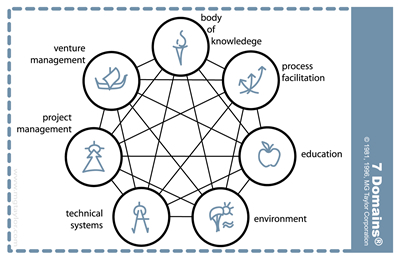 |
|
...Iteration and Recursion and the Model |
| The Model can stand on its own, it can have other models with in it, and/or it can be placed within many of the other Taylor Models. The choice to do so is dependent on what you which to explore, see, understand and/or illustrate. In particular, at the transition points of the step or stages of the models, the Recreation Model is likely to be important. As example, moving from Engineering to Building-Using in the Creative Process; or, from Preliminary to Design Development in Design Formation. It is at moments like these that it is easy to fall into the trap of thinking that this next step is just a simple drilling down of a previous answer - in other words, the temptation is the copy not recreate. All 343 transitions of the Solution Box, call for recreation. Conversely, each transition of the 4 Step process requires a completion of the Creative Process from Identity to Using. If this seems complicated or time consuming, consider this. Creativity is complex. These models make navigation objective and easier. The recreation moment can be a split second of insight or the consequence of a long analytic session involving dozens of people. This is determined by circumstance. It has to happen, however. Creativity is still considered rare. One of the reasons is that commonly employed human processes do not account for the issues being described here. The result is the process stalls and a person thinks they failed or a team is considered to be “not creative” enough. Creative people have learned their own way through this labyrinth. Because their models are often unconscious and unique to a individual or team who has evolved them through practice and rarely considered in context of a system of experiences and processes and generalized theory - thus, they cannot be shared and seem to be in conflict with how others work. The Taylor Models are the result of long observation, decades of use and testing, and, the synthesis of recognized processes from the arts, crafts, science, education and the professions. The Models form a way to facilitate - to make easy - creativity in individual, teams, groups and organization. If learning the language of creativity seems difficult it is not nearly as difficult as trying to “be” creative without this understanding - particularly in a work group environment. |
| An Iteration is not to be confused with repetition. An iteration is a complete cycle of the Creative Process Model which means a “product” shipped and used in a way appropriate [link: appropriate response model] for its Design Formation Stage. Thus, legitimate feedback is possible and the next iteration of work can be informed by the experience. Another critical aspect of iterations is duration and the time between iteration cycles. A so called “iteration” of work which goes on and on and on is not an iteration as described here. Work iterations have have continuity and focus. They begin and end. They are documented, a product is shipped and used. This continuity within a cycle of work is critical. How long this can be is a factor of the work itself and the ability of an individual and team to hold context. When ideas and the work keep cycling and cycling with no progress; when interest dries up and there is no feedback from outside the project, no stimulus, no way to test results; these are signs that work flow and continuity has been broken. And, when an integration is successfully completed the time to the next iteration is equally important. If it is too long, the work starts over - it becomes, essentially, and new beginning not an iteration of the same process. Again this is circumstance determined. People change. Requirements change. The landscape in which the idea, invention, innovation, product is to be used - changes. To continue an “iteration” when continuity between cycles is lost can lead to disastrous circumstances. This, by the way, is one of the greatest fallacies of typical corporate planning “methods.” It should be clear that proper feedback is broken in this circumstance. When too much has changed, when memory has “faded,” when the momentum of a project has stalled, then you know that the iterative process is lost. There is not simple test in terms of time in a cycle or between cycles. However, the patterns of continuity or breaking are consistent and easy to see. |
| Recursion refers to, in the Taylor System and Method, the levels of the system in focus. We use iteration as linear, “horizontal,” sequential. We use recursion as “vertical” and simultaneity acting. It is a premise of this method that a minimum of three iterations of work cooperating with a minimum of three levels of recursion - with feedback occurring from all regions to what we call the “Zone of Emergence” - are necessary for EMERGENCE to happen as a systematic consequence of human intent and action. Emergence, of course can happen anytime under a wide variety of circumstances. This is not contested. Emergence, by definition, cannot be predicted or controlled. This is not contested. Emergence - and more importantly, emergence of the right kind - can be facilitated by providing the right environment around the work. The 3 by 3 grid is minimal. Complex work requires multiple iterations and recursion levels - it is by this means, as well as attenuation - what is left out of the exercise - that Requisite Variety is accomplished. To the degree that the requisite variety equation is not balanced, risk is introduced and the outcome less likely to be satisfactory. |
| The rule of iteration, recursion and feedback is described in Table 2, below, [link: patent tables] and the Zone of Emergence Model, at ValueWeb Mechanics. [link: zone of emergence engine]. |
|
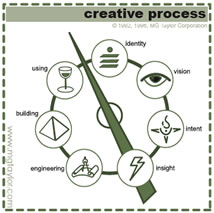 |
At the same scale the Recreation Model fits over the Creative Process Model - and visa versa.
Notice that Vision and Feedback/Using overlap; and that Design Template straddles Intent and Insight; Act, Engineering and Building. The 4 Step process must happen at each transition of the Creative Process. And, is transition of the Four Step much complete a cycle of the entire Creative Process. By the time a project is done, it will have passed through all of the Design Formation Stages.
This is not to be taken as a mechanistic, linear process. The reality is far richer, dynamic and messy than that. The Models are not the reality. The work is. The Models are viewpoints, a way to see slices of what is happening - they are maps, each useful individually and as a book of maps maps of different scales, maps of different kinds, maps which reveal different aspects of the terrain.
Table 2, illustrates the basic flow diagram of the Taylor Method, on three levels of Recursion through three Iterations of work. It also articulates the 6 levels of language by which the method can be described. |
|
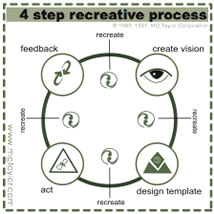 |
|
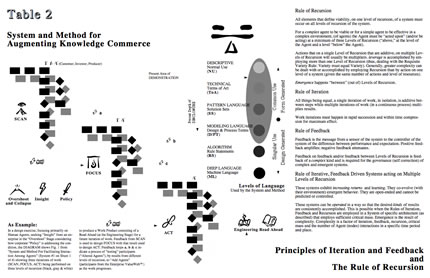 |
click on Table 2 for full size drawing |
| There are many other examples of how the Models fit into one another and augment each other [link: slices of reality]. |
|
| There is another aspect of the Recreation Model which is implied in what I have written yet is worth making very clear. It goes to the heart of collaboration.. |
| How do skilled designers work together, collaboratively, on a complex project without sub-optimizing the whole and yet not compromising the parts and inappropriately subordinating individual contribution? It is actually this question which lead me to the discovery of the 4 Step Model. I found that the answer to the question was buried deep in what is good individual work practices.The answer is found in knowing appropriate hand-off places and in the discipline of recreating the concept and work at each cycle of the work In other words, collaborating designers merely have to treat each other in the same way they should treat themselves: finish a complete iteration of work (the entire creative process) and ship a product (for use) at some known level of Design Formation with good adherence to the “rules of evidence” and “definition of completion” common to, a community-of-work, at this level of expression. |
| This makes a finished product, useful in itself and ready for recreation at the next stage of manifestation. This removes barriers - no matter who takes the task on - the original designer, a new one - or team. |
|
Matt Taylor
Triesen
October 28, 2006
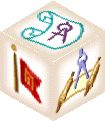
SolutionBox
voice of this document:
ENGINEER • STRATEGY • CONSTRUCTION DOCUMENT
|
click on graphic for explanation of SolutionBox |
posted:
October 28, 2006
revised:
December 19, 2007
• 20061028.802519.mt • 20061105.454502.mt •
• 20070729.000010.mt • 20081215.617720.mt •
• 20081219.081033.mt •
(note:
this document is about 80% finished)
Copyright© Matt
Taylor 1982, 2006, 2007, 2008 |
|
|